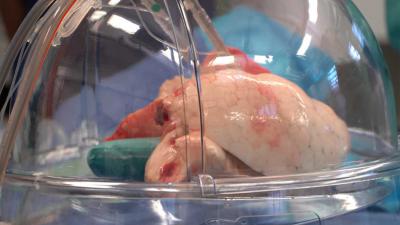Thursday, September 3, 2020 – 9:17 AM Update: 04-09-2020 15:34
‘Above international average’
Sixty percent of the patients are still alive ten years after the transplant. That is well above the international average of 40 percent, ‘says Ersmus MC.
EVLP
In the EVLP, a type of pump, donated lungs are ventilated and flushed with a special fluid for some time. Damage, for example caused by the donor’s stay in an intensive care unit, is repaired as much as possible. For example, there is often fluid in the lungs as a result of edema. “During the donor’s dying process, hormones are produced that ensure that the lungs can fill with fluid,” outline lung specialist Dr Rogier Hoek and cardiothoracic surgeon Edris Mahtab.
Medication added to lungs
Medication can be added during the EVLP procedure. ‘Then you have to think of antibiotics and anti-inflammatories. What is new is that we now also administer clot dissolvers and medication that can limit rejection reactions, ‘say Mahtab and Hoek. ‘We treated lungs with pneumonia in this way. And lungs with a severe embolism, which is a blood clot in a blood vessel in the lung. Normally, these lungs were definitely rejected for transplantation. ‘
Active donor management
Treatment with the EVLP machine is not the only thing that helped the flow in the number of lung transplants. ‘We also started active donor management in 2018. This donor management starts as soon as it is established that the patient will die. Among other things, extra attention is paid to ventilation and fluid balance, so that the lungs are not damaged unnecessarily. ‘
Teamwork
In addition, care for the recipient of the donor lungs is being innovated. ‘Intensive and innovative pre-transplant care, in both the lung department and intensive care, means that more people can be kept in good condition until their transplant. This is truly the result of teamwork between pulmonologists, cardiothoracic surgeons, intensivists, nurses, physiotherapists, dieticians and other disciplines, ”explains Mahtab.
ECMO machine adds oxygen to blood
For example, patients whose lung function threatens to fall below the minimum are connected to an ECMO machine. This is a device that adds oxygen to the blood outside the body and thus takes over the function of the lungs. ‘In this way we can wake people up and get them in enough condition to endure the operation. In the past they had to be taken off the waiting list. ‘
Expansion
With 33 transplants in 2019 and 16 so far in 2020, the result for 2018 is being consolidated, Hoek and Mahtab note. In that year, the number of lung transplants doubled compared to 2017. This profit was achieved by the arrival of the EVLP machine, but also because the Pulmonary Diseases Department had invested in a substantial expansion of the medical team in the previous years. ‘ department books are good, ‘Mahtab and Hoek also know. Hoek: ‘Sixty percent of the patients are still alive ten years after the lung transplant. That is well above the international average of 40 percent. ‘ Most patients also experience a better quality of life than before the lung transplant, research shows.
Waiting list
The expansion of the medical team, the close cooperation between all disciplines involved and the improved EVLP procedure have not resulted in the much desired evaporation of the waiting list. ‘We have to work with donor lungs that are less good than before because donors are aging on average. Moreover, recipients are sicker, ‘says Hoek.
New donor law
Nevertheless, the outcomes after the transplant remained the same and the mortality on the waiting list decreased sharply from 20 to 5 percent. ‘We have high hopes that the new donor law will generate significantly more potential donors.’ Under the new law, everyone is automatically a donor unless he or she registers that he or she does not want to. The same system is used in Belgium and twice as many donors are registered there than in the Netherlands.
– .

/data/photo/2020/07/09/5f0677e42a106.jpg)